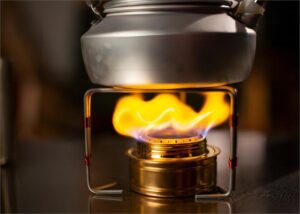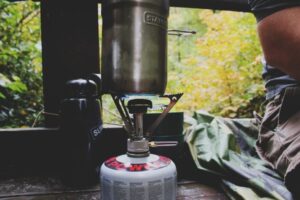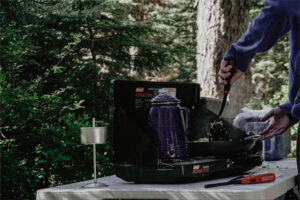
What to look for in a camping stove
Weight
As with any equipment, effectiveness must be weighed against weight concerns. Stove systems are at the heavier end of the range, although more minimalist canister stoves, alcohol, or solid-fuel tablet stoves can provide a lightweight camp cooking alternative.
Packed size
Similarly, the size of your selected camping stove should be assessed with your other equipment. If you want to use your camping stove on multi-day journeys, be sure the burner, pans, and fuel all fit inside a backpacking backpack. If you’re only cooking for one person on a backpacking trip, you can keep things small. If you’re going hillwalking for the day, you might want to consider a bigger choice, but you’ll welcome the extra space in your daypack for layers, a map and compass, food, and water.
Stability
Of course, camp cooking may be risky, particularly during the dry season. everything’s also frustrating to make supper just to lose everything due to an unsteady setup. Stoves, such as remote canister stoves, are the most stable due to their low length and proximity to the ground. Some taller types, such as integrated stove systems, have stabilizing post supports, however these are frequently offered separately. They also add weight to your entire system.
Boil time
Some campers like waiting for their water to boil so they can rehydrate their meal. Others desire instant pleasure while waiting for their coffee in the morning. It is a question of personal choice. However, if you want a speedy and efficient boil time, search for a burner power output wattage ranging from 2,000 to 4,000.
Burner Head
The diameter of your burner head influences the success of your camp meals. Gas stoves with smaller burner heads can create burn zones, or hot areas, on cooking pans. Others are wider to reduce this, but do not cook the contents of tall pots as rapidly. A modest diameter should enough for boiling water, but for cooking solid items, a broader head may be required to prevent your noodles from crisping to the bottom of the pot.
Flame regulation
A flame regulator will be useful for any camp cooking that is not limited to boiling water. The good news is that most modern camp stoves include a control valve that allows you to alter the intensity of the flame.
Wind Protection
Almost every camper has experienced the way winds and gusts can pick up in high areas. So, you’ll need to invest in wind protection for your camping stove or risk losing its efficiency. Windshields improve efficiency by protecting against the weather and acting as a heat reflector. These can be incorporated or constructed from thin aluminum sheets.
The different types of camping stoves
Canister camping stoves
Canister stoves are simple to operate, need little maintenance, and can be quite lightweight, making them the most frequent form of camping stove you’ll find up in the hills. Simply put the burner head into the gas canister, light, and you’re good to go. The disadvantages include stability concerns, which can be mitigated by broad, serrated pan supports, and difficulty determining the amount of gas remaining in your canister, necessitating the use of a backup canister.
Remote canister camping stoves
Similar to canister stoves, these types include a free-standing burner head that connects to a gas canister via a flexible hose. They provide higher stability and efficiency than standard canister stoves since they are lower to the ground. They also occasionally allow the canister to be inverted for improved performance in cold temperatures.
Stove wood-burning camping stoves
Bushcraft enthusiasts prefer wood stoves, which can be a lot of fun to use, such as the Solo Stove Titan. They can be simple and lightweight – you find your fuel (twigs and dry wood) in nature – and are frequently made of materials such as titanium and can fold flat. However, they are less trustworthy and are likely to be avoided by individuals concerned about wildfire or forest loss. Similarly, damp weather might make it difficult to obtain dry wood.
Alcohol stoves
Alcohol is simple and light. The finest designs include a windshield as well as pot support, which can result in faster boil times. Indeed, this style of camping stove takes longer to boil water than gas, has less change in flame strength for simmering, and the alcohol fuel reserves are large during extended trips. However, they are quiet, inexpensive to operate, can be more ecologically friendly, and provide a back-to-basics feel.
Liquid and multifuel camping stoves
This style of camping stove, such as the Optimus Polaris Optifuel, runs on white gas or paraffin, petrol, diesel, and even aviation (jet) fuel. They may be quite strong and are even effective in melting snow on winter camps. They are also a solid solution for international backpackers, as well as treks to distant places of the world where gas may not be accessible.
However, they are likely to be significantly heavier than a canister stove and will require more priming and maintenance. Additionally, gasoline leaks are probable.
Our Camping Stove Picks
Now that you have an idea what you need in a camping stove, check out our website https://www.deermaple.com/ for best camping stoves.










